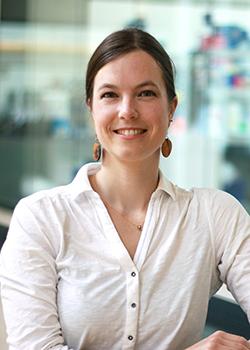Research Interests
I am a theoretical biologist — I study biological phenomena by making computer models to simulate the underlying processes. My research centres around the evolutionary dynamics of developmental processes, also known as evo-devo. At the Sainsbury Laboratory I am employing computational models to study the long-term evolution of plant development and integrating understandings of how gene regulatory networks and dynamical processes that generate complex morphologies can evolve.
Understanding how multicellular life has changed and how undifferentiated cells have established patterning and shape to develop into complex organs will tell us more about how plants have evolved. The time scales of these evolutionary processes are vast, and therefore difficult to study in the lab alone. By constructing computer models I can simulate an evolving population of plants which have to grow and develop. When a successful plant reproduces, its offspring will inherit their genome, with mutations. In this way, I can simulate thousands of years of evolution in days or weeks, and store a perfect fossil record of all the changes in the developmental program. This allows me to study in detail how, over evolutionary time, the accumulation of mutations leads to new developmental programs that make new organs. By switching up the starting conditions or the environment, we can dissect why modern plant organs function the way they do now.
How did we get so many complex species? A public outreach video explaining my field of research within the Origins Center for a
broad audience.
Before joining SLCU in August 2021, I was at the Origins Center in the Netherlands, where I worked on the evolution of multicellularity: what selection pressures can cause cells to stick together, and how cells change their behaviour once they are in a group. During my PhD at Utrecht University I studied the evolution of segments, which are repeated patterns in animal bodies, like vertebrae or the partitioned armour of insects. In both plants and animals, embryonic development generates a complete multicellular organism from a single, fertilised egg cell. This is a program which is (mostly) encoded in the genome. I hope to find general principles of evolution that are shared between plants and animals, as well as interesting and informative differences.
Other Activities
- SMB Cell and Developmental Biology subgroup (2020 - )
- scientific committee member
- Organising committee Origins Center 2021 meeting (2020 - )
- scientific advisory member
- IAS art-science group (2019 - )
- Co-founder of an informal discussion and experimentation group on the interface between art, science and philosophy.
Talk to Modelling in Ecology and Evolution Meeting on "Evolution of multicellularity by collective integration of spatial information".
Key Publications
View all publications on Google Scholar
Vroomans RMA, Colizzi ES. 2023. Evolution of selfish multicellularity: collective organisation of individual spatio-temporal regulatory strategies BMC Eco Evo 23 (1), 35
Colizzi ES, Van Dijk B, Merk RMH, Rozen DE, Vroomans RMA. 2023. Evolution of genome fragility enables microbial division of labor Mol Sys Biol 19 (3), e11353
Colizzi, E. S., Hogeweg, P., & Vroomans, R. M. (2022). Modelling the evolution of novelty: a review. Essays in Biochemistry, 66(6), 727-735.
Colizzi, E. S., van Dijk, B., Merks, R. M., Rozen, D. E., & Vroomans, R. M. (2023). Evolution of genome fragility enables microbial division of labor. Molecular Systems Biology, 19(3), e11353.
Hagolani PF, Zimm R, Vroomans RMA, Salazar-Ciudad I. 2020. On the evolution and
development of morphological complexity: a view from gene networks accepted in PLoS
Comput Biol
Colizzi ES, Vroomans RMA, Merks RMH. 2020. Evolution of multicellularity by collective
integration of spatial information. ELife
Ritmahan W,Kesmir C, Vroomans RMA. 2020. Revealing factors determining immuno-
dominant responses against dominant epitopes. Immunogenetics, 1-10
Li XR, Vroomans RMA, Fox S, Grieneisen VA, Ostergaard L, Maree AFM. 2019.
Systems biology approach pinpoints minimum requirements for auxin distribution during
fruit opening. Molecular plant, 12:6
Bagaev DV, Vroomans RMA, Samir J, Stervbo U, Rius C et al.,. 2020. VDJdb in 2019:
database extension, new analysis infrastructure and a T-cell receptor motif compendium.
Nucleic Acids Research 48 (D1), D1057-D1062
Vroomans RMA, Hogeweg P, Ten Tusscher KHWJ. 2019. Around the clock: gradient
shape and noise impact the evolution of oscillatory segmentation dynamics. EvoDevo
9:24
Shugay M, Bagaev DV, Zvyagin IV, Vroomans RMA, Crawford JC et al.,. 2018. VDJdb:
a curated database of T-cell receptor sequences with known antigen specificity. Nucleic
acids research 46 (D1), D419-D427
Vroomans RMA, Ten Tusscher KHWJ. 2018. Chapter: Modeling Evolution of Develop-
mental Gene Regulatory Networks. In Evolutionary Developmental Biology, Springer
Reference
Vroomans RMA, Ten Tusscher KHWJ. 2017. Modelling asymmetric somitogenesis:
Deciphering the mechanisms behind species differences. Dev Biol 427(1): p21-34
Vroomans RMA, Hogeweg P, Ten Tusscher KHWJ. 2016. In silico evo-devo: recon-
structing stages in the evolution of animal segmentation. EvoDevo 7:14
Vroomans RMA, Hogeweg P, Ten Tusscher KHWJ. 2015. Segment-specific adhesion as
a driver of convergent extension. PLoS Comput Biol 11(2): e1004092
Vroomans RMA, Maree AFM, de Boer RJ, Beltman JB. 2012. Chemotactic migration
of T cells towards dendritic cells promotes the detection of rare antigens. PLoS Comput
Biol 8(11): e1002763

